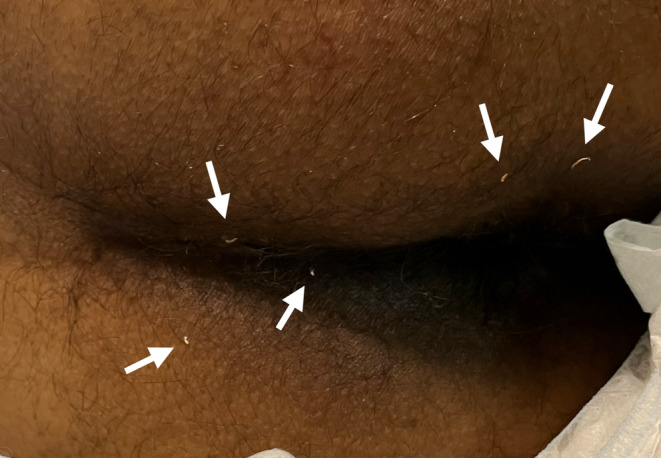Abstract
A 33‐year‐old hospitalized patient felt itching around his anus. Tiny white thread‐like worms were observed around his perinatal region. Microscopic examination revealed the presence of elongated, one‐sided, flattened eggs inside the worm.

Keywords: Enterobiasis, Enterobius vermicularis, pinworm infection
A 33‐year‐old Sri Lankan man, who had been living in Japan for the past 2 years, was admitted to the orthopedic ward because of a traumatic vertebral fracture. During admission, the patient felt itching near his anus. He denied any other symptoms. On examination at night, tiny white thread‐like worms were observed in his perianal region (Figure 1). Additional history taking revealed that he had several episodes of pinworm infection in Sri Lanka and had been treated repeatedly with albendazole. We identified the nematode as Enterobius vermicularis based on the presence of elongated, one‐sided, flattened eggs (Figure 2). We prescribed a single dose of albendazole 400 mg and repeated it after a 2 week interval. His symptoms improved, and the worms disappeared after the treatment.
FIGURE 1.

Tiny thread‐like worms are seen in the patient's perianal region (white arrows).
FIGURE 2.

Adult female Enterobius vermicularis with numerous eggs. The specimens were collected with scotch tape and observed under an optical microscope (40×).
Enterobiasis (also known as pinworm infection) is caused by E. vermicularis.
Adult worms of E. vermicularis, with males measuring 2–5 mm and females 8–13 mm, live primarily in the cecum of the large intestine. Gravid female worms migrate at night to lay eggs on the perianal skin. The egg can be spread to the original host and to new hosts through the fecal–oral route. E. vermicularis is distributed worldwide, infecting an estimated 209 million individuals. 1 In Japan, the incidence of Enterobiasis was 21.7% in 1961 but has since decreased to 0.10% in 2015 because of improved sanitation conditions. 2 A screening test with the scotch tape had been mandatory for school children in Japan but was discontinued in 2016 because of the low incidence. 3 As a result, physicians in Japan rarely encounter enterobiasis. Although enterobiasis is an almost neglected disease in Japan, physicians should keep it in mind because it is still endemic in other countries.
CONFLICT OF INTEREST STATEMENT
The authors declare no conflict of interest.
PATIENT CONSENT STATEMENT
Written informed consent was obtained from the patient for publication of this clinical image.
ACKNOWLEDGMENTS
None.
Muranaka E, Okawa N, Tsuyama N, Mito H, Yano Y, Hase R. Enterobiasis in the hospitalized patient. J Gen Fam Med. 2023;24:266–267. 10.1002/jgf2.628
REFERENCES
- 1. Kucik CJ, Martin GL, Sortor BV. Common intestinal parasites. Am Fam Physician. 2004;69(5):1161–8. [PubMed] [Google Scholar]
- 2. Ohno N. Epidemiological investigation of parasitic infection of schoolchildren. Tokyo Health Serv Assoc Annu Rep. 2017;46:58–60. (in Japanese). [Google Scholar]
- 3. Hamano S. Enterobiasis. Japan Med J. 2021;5074:37 (in Japanese). [Google Scholar]


